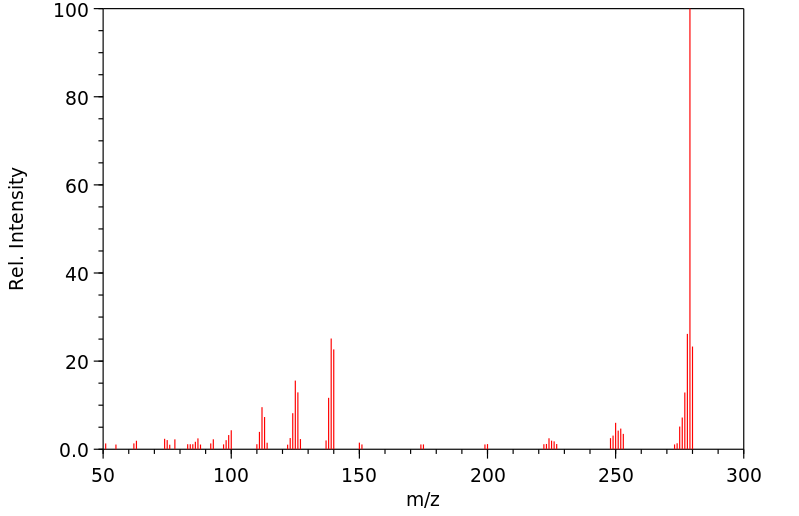代谢
作者们研究了二苯并(a,h)吖啶(DB(a,h)ACR),一种具有两个不同海湾区域的aza-PAH,通过重组人细胞色素P450 1A1、1B1和3A4以及大鼠P450 1A1的生物转化。在三种P450中,1A1在代谢DB(a,h)ACR方面最有效,其次是1B1和3A4。人类P450 1A1和1B1产生的主要DB(a,h)ACR代谢物是具有海湾区域双键的二氢二醇,即DB(a,h)ACR-3,4-二醇和DB(a,h)ACR-10,11-二醇(假定直接致癌物)。P450 1A1产生的DB(a,h)ACR-10,11-二醇(来自靠近氮的苯环)的比例(44.7%)高于DB(a,h)ACR-3,4-二醇(来自远离氮的苯环)的比例(23.8%)。相比之下,1B1产生的3,4-二醇比例(54.7%)远大于10,11-二醇比例(6.4%)。这些数据表明,(i)人类P450 1A1和1B1在DB(a,h)ACR的区域特异性代谢方面存在显著差异,(ii)人类P450 1A1在将aza-PAH代谢激活为其10,11-二醇方面比人类P450 1B1活性更高,以及(iii)氮的存在影响人类P450 1A1和1B1形成具有海湾区域双键的两个苯环二醇的相对程度。与人类P450 1A1和1B1不同,大鼠P450 1A1在代谢DB(a,h)ACR时没有区域选择性,几乎等量产生10,11-二醇和3,4-二醇。尽管它们在区域选择性方面存在显著差异,但人类P450 1A1和1B1以及大鼠P450 1A1在将DB(a,h)ACR代谢为其具有海湾区域双键的二醇方面显示出类似的立体选择性,主要产生R,R对映体(>94%)。这些研究的数据表明,人类和大鼠P450 1A1在将DB(a,h)ACR代谢为其两个具有海湾区域双键的苯环二醇方面在区域选择性上存在差异,因此在代谢激活母体aza-PAH的能力上也有所不同。然而,人类和大鼠P450 1A1在将DB(a,h)ACR代谢为其二醇的立体选择性方面没有差异。
... /The authors/ have investigated the biotransformation of dibenz(a,h)acridine (DB(a,h)ACR), an aza-PAH with two nonidentical bay regions, by recombinant human cytochromes P450 1A1, 1B1, and 3A4 and rat P450 1A1. Among the three P450s, 1A1 was the most effective in metabolizing DB(a,h)ACR followed by 1B1 and 3A4. The major DB(a,h)ACR metabolites produced by human P450 1A1 and 1B1 were the dihydrodiols with a bay region double bond, namely, DB(a,h)ACR-3,4-diol and DB(a,h)ACR-10,11-diol (putative proximate carcinogen). P450 1A1 produced a higher proportion of DB(a,h)ACR-10,11-diol (derived from the benzo ring adjacent to the nitrogen) (44.7%) than of DB(a,h)ACR-3,4-diol (derived from benzo ring away from the nitrogen) (23.8%). In contrast, 1B1 produced a much greater proportion of 3,4-diol (54.7%) than of 10,11-diol (6.4%). These data indicate that (i) human P450 1A1 and 1B1 differ dramatically with respect to the regiospecific metabolism of DB(a,h)ACR, (ii) human P450 1A1 is substantially more active than human P450 1B1 in the metabolic activation of the aza-PAH to its 10,11-diol, and (iii) the presence of nitrogen influences the relative extent to which the two benzo ring diols with a bay region double bond are formed by human P450s 1A1 and 1B1. In contrast to human P450s 1A1 and 1B1, rat P450 1A1 showed no regioselectivity in the metabolism of DB(a,h)ACR producing nearly equal proportions of 10,11-diol and 3,4-diol. Despite significant differences in their regioselectivity, human P450 1A1 and 1B1 and rat P450 1A1 showed similar stereoselectivity in the metabolism of DB(a,h)ACR to its diols having a bay region double bond, producing primarily the R,R enantiomers (>94%). The data of these studies indicate that human and rat P450 1A1 differ in their regioselectivity in the metabolism of DB(a,h)ACR to its two benzo ring diols with a bay region double bond and consequently in their ability to metabolically activate the parent aza-PAH. However, human and rat P450 1A1 do not differ with respect to their stereoselectivity in the metabolism of DB(a,h)ACR to the diols.
来源:Hazardous Substances Data Bank (HSDB)







